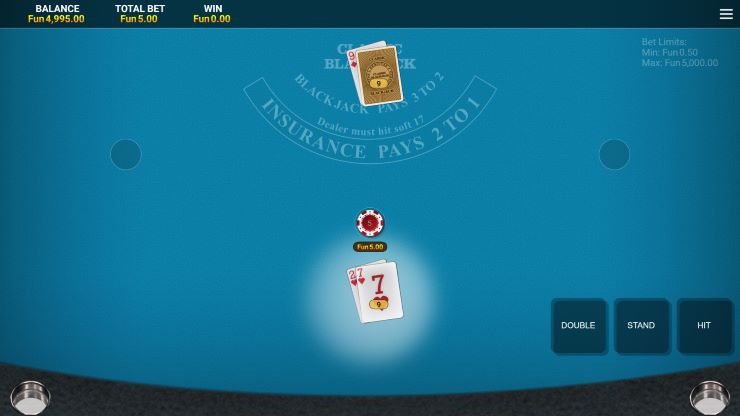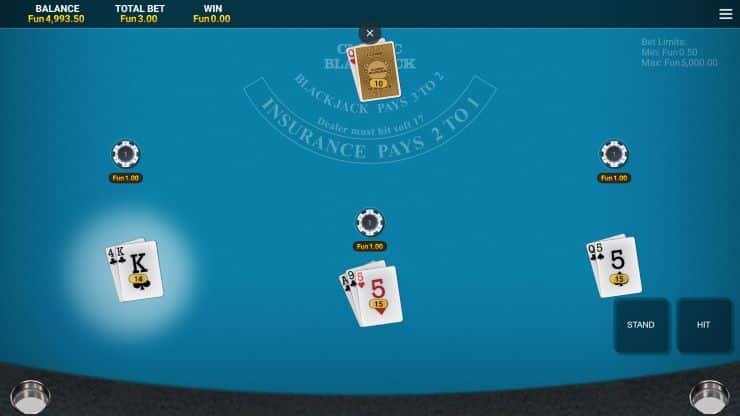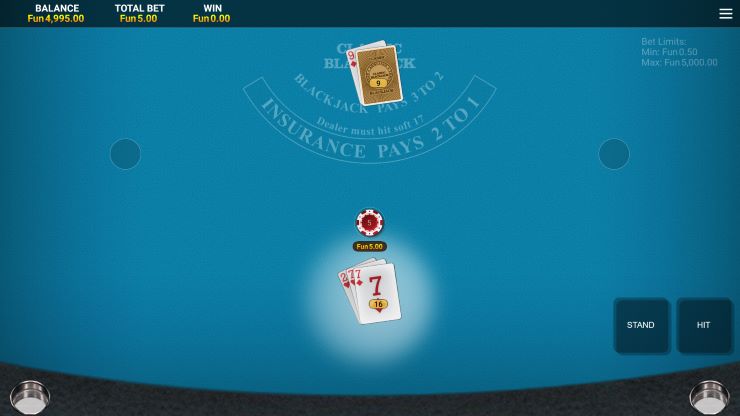Aneeca is an experienced, skilled writer in the gambling niche. She has been reviewing online casinos for years, putting special focus on player-friendly features, while her expert guides on how to play casino games have been published on many reputable websites. In her free time, Aneeca enjoys playing board and video games with her friends.
All posts by Aneeca YounasWriter and editor with over 15 years of experience in the iGaming industry, having worked for TeamTalk, ClubCall, Planet Sport and several Tier 1 and Tier 2 sportsbooks. Passionate Middlesbrough FC supporter.
All posts by Andrew MorganWhat is surrender in blackjack, and how does it work to your advantage as a player? We answer these questions and more by providing insight into this strategy, what it means, and when to surrender in blackjack.
We cover everything there is to know about this lesser-known blackjack bet to give you an advantage when playing your next online game.
- Show full guideShow less
What is Blackjack Surrender?
Surrender in blackjack is a discretionary rule in the card game that allows you to fold your hand instead of hitting or standing. This option comes into play once you have seen your first two cards and the dealer’s upcard.
Choosing to opt for blackjack surrender means you automatically give up 50% of your original stake and only receive the remaining 50% back. As a result, you only lose half your wager instead of continuing play in an instance where you have a bad hand and possibly lose your entire stake.
It is a good time to surrender in blackjack when your hand has a less than 50% chance of winning.
Now that we have answered the question of what is a surrender in blackjack, it is important to note that there are two types of surrender rules: early and late surrender, which we will discuss further down.

How to Surrender in Blackjack?
Besides knowing what a surrender is in the blackjack game, knowing how to wager the bet is important. When choosing to surrender, you forego the option to stand or hit by folding, receiving back half of your original wager, and sitting out the round.
A blackjack surrender has a reduced house edge, which makes it a popular bet among players who visit the top live online blackjack casinos in search of a more professional game.
Notably, not all blackjack games offer the surrender rule. If you’re playing live blackjack, you’ll need to swipe a finger behind the bet to indicate that you want to wager a surrender bet.
However, if you’re playing blackjack online, you’ll find a unique button to click, giving you access to place this wager.
Playing surrender is straightforward as it follows the same principles as 21. However, just as when playing blackjack, you have an understanding of when to split, hit, or stand, you should also know when it is best to forfeit the round and withdraw your hand.
When Should You Surrender in Blackjack?
Understanding when to surrender in blackjack is just as essential as knowing how to place the bet, especially if you want to make the most out of the wager since you’re opting to lose half your stake.
The best time to invoke the blackjack surrender rule is when the odds are firmly against you. This way, you get to cut your losses and still walk away with half your stake.
There are several points in a blackjack game that make it clear that opting to surrender is your best bet. These include the following:
Instance Your Hard Hand Dealer’s Upcard 1 16 9, 10, Ace 2 15 10, Ace 3 17 Ace As per the table above, if your opening hand has a value between 15 and 17 and the dealer’s upcard has a value of a 9, 10, or Ace, surrendering is your best bet.
However, it is important to note that there are two types of blackjack surrender—early surrender and late surrender —depending on the variant of the game you’re playing.
What Is Early Surrender in Blackjack?
So, what is Early Surrender in blackjack? Early surrender gives you the chance to fold and withdraw your bet once you have received your two cards and the dealer’s upcard is face up, but their hole card has yet to be revealed. In this instance, you receive 50% of your original stake back.
Early surrender has a significant effect on the house edge. This betting option first came into play in the late 70s when the Casino Control Commission in Atlantic City decided to introduce more lax rules in the hopes of attracting more players. However, since this bet knocked a whopping 0.6% off the house edge, it caused more damage than good. As such, the rule is rarely offered at land-based casinos. You’re more likely to find this option at online casinos offering blackjack. But make sure to check the online casino’s house rules first before engaging in the bet to ensure there are no other stipulations in place designed to make up for the loss on the house edge.
If the casino’s house rules seem legit, the best instances to implement the surrender strategy include:
- When you receive a hand of 14, 15, or 16, and the dealer has an upcard of 10.
- When you have a hard 5, 6, 7 and 12, 13, 14, 15, 16, and 17, and the dealer has an Ace as their upcard.
- If the dealer hits soft 17, surrender your hard 4.

What Is Late Surrender in Blackjack?
So, what is late surrender in blackjack, and how does it differ from early surrender?
Late surrender offers the same option as early surrender, but you can only opt to forfeit your hand after the dealer has revealed their hole card and checked their hand for blackjack. In this case, you only receive half your original stake back if the dealer has blackjack, significantly minimizing the effectiveness of the surrender bet.
However, when used in a game with 6+ decks in the shoe, late surrender can lower the house edge by 20% overall, making it a valuable strategy.
Notably, the option for a late surrender is not openly advertised at a land-based casino, and you’ll need to check with the croupier whether it is available before the game begins. To signal that you want to surrender when playing live roulette, you must draw a horizontal line behind your bet and simultaneously state aloud your intent to surrender. However, this can change from casino to casino, so it helps to check with your croupier what the correct etiquette is before the game begins.
Conversely, the option for a late surrender is often offered at online blackjack casinos and is clearly detailed in the game rules.
The best time to opt for a late surrender includes:
- When the game has four or more decks, you’re dealt a 16, and the dealer’s upcard is a 9.
- If you receive a 16 or a 15 (unless it’s a single-deck game) and the dealer’s upcard is a 10.
- If you have a 15, 16, or 17, and the dealer’s upcard is an Ace.

Blackjack Surrender Strategy
The use of surrender in blackjack comes down to calculating the probability of your winning with the hand you’re dealt. There are specific instances when implementing the surrender blackjack strategy becomes your best option. Let’s review three instances where you would consider implementing the surrender strategy:
- Instance 1: Your hand is a 16, and the dealer’s upcard is a 9,10, or Ace
- Instance 2: Your hand is a 15, and the dealer’s upcard is a 10 or an Ace
- Instance 3: Your hand is a 17, and the dealer’s upcard is an Ace
In the first instance, if you chose to hit, your probability of going bust is 61.6%, while your chances of increasing your hand to a value of between 18 and 21 is only 30.8%. Conversely, the dealer has a probability of 57.1% of getting their hand to a value of 18 to 21. As such, the odds here are against you, making it a better option to surrender.
The second instance sees the dealer with a probability of 78.6% (10) or 88.3% (Ace) of winning should you choose to hit. Choosing to hit leaves you with a 58.1% probability of going bust and only a 15.3% chance of landing a hand valued between 20-21. However, the dealer has a higher 38.4% chance of making blackjack. Again, here the odds are clearly against you.
Related Content: Blackjack Odds Explained
The final instance sees you landing a hard hand of 17 and the dealer with an Ace as their upcard. Choosing to hit here leaves you with a 69.2% probability of going bust. Likewise, standing gives the dealer a 61.5% probability of reaching a higher value hand with their hole card or having the chance to hit and build their hand value.
Total Dependent vs Composition Dependent
When you decide whether to surrender based only on the total of your first two cards, we call this “total dependent.”
However, there is another set of rules for “composition-dependent” surrender that focuses on the groupings of cards that make up your hand value. As an example, you may receive a 9 and a 6 or an 8 and a 7. These both total 15 but have different card groupings.
In this case, if you are playing a single deck game, you’ll want to surrender the 9,6 combination but play an 8,7 combo. This is just one of many exceptions, making the composition-dependent rule one best left to the pro players.
Conclusion
Surrender in blackjack is a discretionary rule that allows you to fold your hand and opt out of the round, earning back only 50% of your original stake. There are two variants of surrender, early and late surrender, both of which are only available when playing specific variants of the game. While this strategy can be beneficial in some instances and serves to lower the house edge, it pays to know when to use this option for advantageous gameplay.
We hope we have answered your questions like what is surrender in blackjack and shed some light on this rare but handy betting option.
Blackjack Surrender FAQs
What does surrender mean in blackjack?
Surrender in blackjack is an optional wager that you can opt for as an alternative to standing or hitting once you have received your initial two cards and the dealer has revealed their upcard. If your hand has a 50% or more chance of losing, you can choose to surrender, which means you fold your hand and opt out of the round. In this case, you receive back a portion of your initial wager.
What is early surrender in blackjack?
An early surrender is where you opt to surrender your bet after the dealer reveals their upcard but before they show their hole card. Here, you review your own total value of the first two cards you’re dealt and decide whether your chances of winning are below 50%. If they are, you can opt for an early surrender. Here, you will receive back 50% of your original stake.
What is late surrender in blackjack?
Late surrender in blackjack follows the same principles as early surrender but with a few differences. You may only opt for a late surrender once the dealer has checked and revealed their hole card. If they have blackjack, you receive back 50% of your original stake. However, if they don’t, you forfeit your entire stake.
When to surrender in blackjack?
The best time to surrender in blackjack is when one of the following three instances arise: Your hand is a 16, and the dealer’s upcard is a 9,10, or Ace, OR your hand is a 15, and the dealer’s upcard is a 10 or an Ace, OR, your hand is a 17, and the dealer’s upcard is an Ace. In these cases, your chances of winning sit well below 50%, while the dealer has a much higher chance of landing a card that boosts their hand value well above yours, or they get the opportunity to hit for a third card that brings them to a value of between 20-21. SInce the odds here do not fall in your favor, opting to surrender makes the most sense and saves you half of your original stake.
Aneeca is an experienced, skilled writer in the gambling niche. She has been reviewing online casinos for years, putting special focus on player-friendly features, while her expert guides on how to play casino games have been published on many reputable websites. In her free time, Aneeca enjoys playing board and video games with her friends.
All posts by Aneeca YounasAneeca is an experienced, skilled writer in the gambling niche. She has been reviewing online casinos for years, putting special focus on player-friendly features, while her expert guides on how to play casino games have been published on many reputable websites. In her free time, Aneeca enjoys playing board and video games with her friends.
All posts by Aneeca Younas